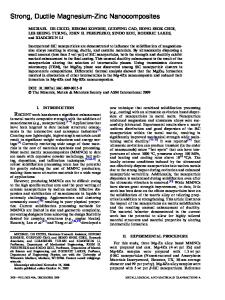Room-temperature ductile carbides
- PDF / 5,553,965 Bytes
- 7 Pages / 612 x 792 pts (letter) Page_size
- 109 Downloads / 402 Views
INTRODUCTION
CARBIDES are some of the hardest, stiffest, and most refractory materials known. The carbides of tungsten, silicon, and titanium, to name a few, all possess hardnesses in excess of 25 GPa and are thermally stable to at least 2000 7C. A notable exception is the ternary carbide Ti3SiC2, first synthesized over 30 years ago by Jeitschko and Nowotny,[1] who also determined its structure to be hexagonal with layers of TiC interleaved with hexagonal nets of Si. Later, Nickl et al.,[2] working with chemically vapor-deposited (CVD) films and small single crystals of Ti3SiC2, measured hardnesses that were quite low when compared to other carbides and were anisotropic (3 to 4 and 12 to 15 GPa, respectively, when tested parallel to and normal to the basal planes). They noted that their CVD samples showed unusual ‘‘plastic’’ behavior that was reminiscent of graphite. Later, Goto and Hirai,[3] also working with CVD samples, reconfirmed the earlier results and reported a hardness of 6 GPa. More recently, Pampuch and co-workers,[4,5,6] working with samples that contained at least 10 vol pct TiCx, reported a Young’s modulus of 325 GPa and noted that, since the ratio of the hardness to the modulus was quite low, this somehow indicated that the material was plastic. Most recently, the authors fabricated and characterized bulk, polycrystalline single-phase samples of Ti3SiC2 as well as some of the closely related 211 phases or M2BX, where M is a transition metal, B is a B-group element, and X is either carbon or nitrogen.[7–15] As a class, these carbides are good thermal and electrical conductors, relatively soft, with hardnesses in the range of 3 to 6 GPa, and machinable.[7–10] Furthermore, Ti3SiC2 is damage tolerant, resistant to thermal shock,[7,11,13] relatively light (4.5 gm/cm3), elastically rigid, oxidation resistant, and stable up to at least 1700 7C.[12,14] Polycrystalline samples fail in a brittle manner at room temperature, but deform psuedoplastically at temperatures greater than 1200 7C.[13] At 1300 7C, the ‘‘yield’’ stresses (defined as the stress at which the stressstrain curve deviates from linearity) are 100 and 500 MPa in flexure and compression, respectively.[13] Atomistically, basal plane dislocations, with b 5 1/3 [1120], multiply and are mobile at room temperature.[15] M.W. BARSOUM, Professor, and T. EL-RAGHY, Research Assistant Professor, are with the Department of Materials Engineering, Drexel University, Philadelphia, PA 19104. Manuscript submitted January 28, 1998. METALLURGICAL AND MATERIALS TRANSACTIONS A
In our work and that of others,[2–6] there have been some hints that the unusual combination of properties observed are somehow related to ambient temperature plasticity. For example, single buckled grains are easily identifiable in the vicinity of Vicker’s hardness indentations,[11] the material is softer and more damage tolerant than other carbides,[11,13] and it posesses the low hardness-to-modulus ratio alluded to previously.[5] The evidence to date, however, has been indirect. In this a
Data Loading...










